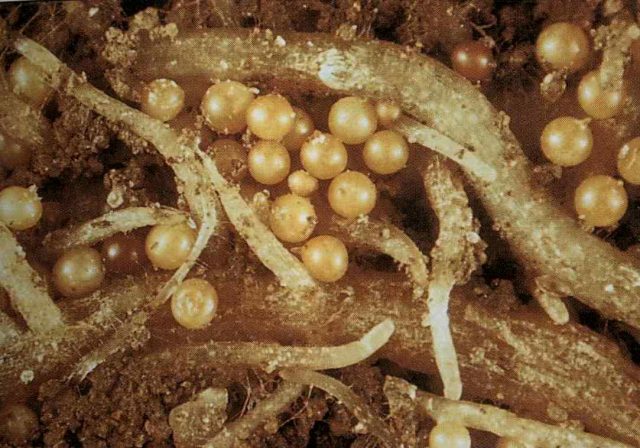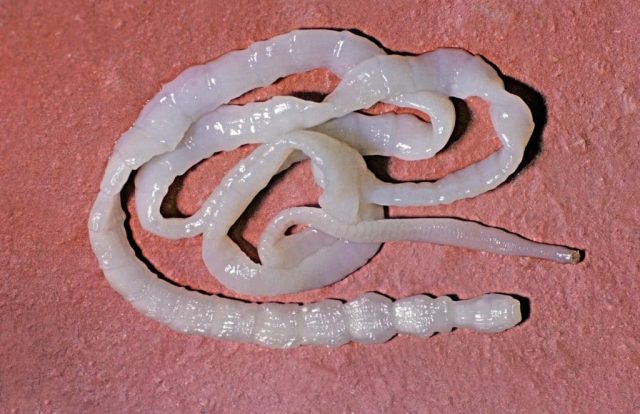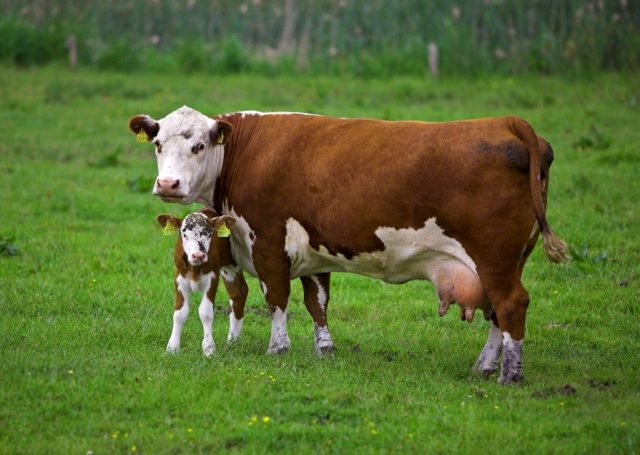Content
If there is a decrease in milk yield in a herd, cows lose weight for no apparent reason, and mortality rates increase, then most likely the cause is worms in cattle. There are various parasites in the body of the animal, the disease often proceeds without symptoms, so it is important to remember the methods of prevention and know how to treat cows. Most often, calves are susceptible to helminthic invasion, the treatment of which is difficult.
Cattle parasites
Various types of worms cause helminthiases in cattle, they settle in the intestines, heart, kidneys, liver or lungs of the animal. The most common occurrences in cows and calves are:
- gastrointestinal nematodes;
- respiratory roundworms;
- subcutaneous, cardiac and other nematodes;
- trematodes;
- cestodes.
All worms are similar in morphological characteristics, but outwardly different. The methods of defeat are also different.
Gastrointestinal worms in cattle are of several types.
Species name | Description |
Bunostomum | The parasite is grayish in color, no more than 3 cm long. It is found in regions with a humid and warm climate. Worms settle under the skin, can affect the lungs |
Сooperia | Red worms up to 10 mm widespread |
Gongylonema | Yellow-brown worm, up to 14 cm long. Males - no more than 6 cm.Worms affect the esophagus and stomach walls |
Haemonchus | The parasites are red, the body is up to 3 cm in length. They live everywhere in pastures. Worms settle in the stomach and liver of cattle |
Nematodirus | White worms - up to 2.5 cm. They are found in regions with a temperate climate |
Oesophagostomum radiatum | They live in regions with hot and humid climates. The body of the parasite is up to 25 mm. Live in the small intestine |
Ostertagia | Worms are common in the Northern regions. Thin worms of brown color - up to 12 mm long. Affect the young |
Strongyloides | Occur in farms with violations of sanitary standards. Parasites are almost transparent in color, no more than 6 mm long. Sett in the lungs and intestines |
Toxocara vitulorum | Worms are ubiquitous. Outwardly they look like boiled spaghetti. Worms live in the small intestine and stomach of cattle |
Trichostrongylus | Parasites are common everywhere. These are red-brown worms - from 5 to 10 mm long |
Respiratory roundworms affect young cattle in cold and humid regions where it often rains. These are medium-sized parasites, up to 8 cm long, white or gray. Most often, worms affect the respiratory tract and cause bouts of severe coughing. With advanced invasion, pulmonary edema or pneumonia occurs.
Of the subcutaneous worms in Russia, the genus Parafilaria bovicola is most often found in cattle. These are white worms up to 6 cm long. They settle under the skin of calves in the back and abdomen.
Trematodes, or flat worms, are common throughout the world. These are oval-shaped parasites, the body of which does not exceed 30 mm in length. They have oral and abdominal suction cups. The color can be from white to dark red, depending on the species. Most often they parasitize in the stomach and small intestine.
Tapeworms or cestodes in cattle are in the larval stage until they enter a suitable environment. In some cases, they pose little threat to cows and calves. But there are exceptions, such as the Moniezia worm. It grows in the body of cattle and reaches a final size of 10 m.
How does the infection take place
The defeat of cows with worms occurs through the larvae, which enter the body of cattle along with food or water. Even compliance with all sanitary standards does not guarantee that there are no parasites in the herd.Animals can become infected with worms while walking by eating grass, beetles and other food.
The defeat by nematodes occurs mainly in the pasture, when young cattle are walking with adult cows. The larvae of the worms enter the bloodstream of the animal, from where they get to all the organs of the calf. For more than 3 weeks, the parasite lives in the body, gradually growing up and laying new larvae. Worms ready for invasion, getting into the external environment, remain viable at temperatures up to 27 ° C. At higher rates, their development is inhibited, but does not stop. If a cow becomes infected with worms in the fall, then the larvae remain in her body until spring.
Tapeworms are most common in young animals. Cattle enter the body together with a pasture mite, which swallows up to 200 larvae of worms. After 15-20 days, the worm becomes sexually mature and ready to reproduce.
Symptoms of helminths in cattle
If the worms have settled in the liver or other organs of the cow, then only a veterinarian can determine the degree of invasion. The owner should pay attention to the external signs and symptoms of the lesion:
- the animal is depressed, depressed;
- tousled wool;
- no appetite or weak;
- young cattle are lagging behind in development;
- diarrhea is observed;
- anemia occurs;
- if the respiratory tract is affected, coughing, wheezing occurs;
- purulent discharge appears from the nose;
- young cattle lose weight, exhaustion sets in.
If you do not start treatment for worms in time, then the death of calves and cows occurs as a result of intestinal blockage, choking with balls of helminths or exhaustion. Recovery is possible, but such an animal is not suitable for breeding.
In some cases, there are no obvious signs of helminths. However, the quantity and quality of milk is decreasing. A pregnant cow has a miscarriage or postpartum stagnation.
Deworming cattle
Infection with helminths occurs quickly. The whole herd suffers from one sick animal, so the fight against worms begins immediately.
Therapeutic
To medically relieve cattle calves from worms, you need to inject drugs into the throat of a sick animal. The process of destroying helminths begins in the stomach, where the antihelminthic agent enters.
Before processing the animal, you need to correctly calculate the weight so as not to cause poisoning and overdose. The cow's head is held tilted, forcing her to drink the mixture.
All drugs for worms in cattle have severe side effects, so you cannot make a decision on treatment yourself. First, you need to accurately establish the diagnosis, consult a veterinarian.
Preventive
For the purpose of prevention, deworming is done 2 times a year. Typically in spring and autumn. Medicines should be distributed to all animals, as time passes from the lesion to the first symptoms.
Preparations for cattle from parasites
There are a lot of drugs for the treatment of cows from worms. These are pills, powders, injections. They are selected depending on the type of parasite.
The most common drug for various nematodes is "Tetramisole". The granules of this agent are mixed with drinking water and forcibly poured into the mouth of the cattle. The drug is distributed in the fall, when the animal is no longer on the walk. For one adult, 45 g is calculated, while the calf is given 15 g for every 10 kg of weight. Under the influence of "Tetramisole", diarrhea stops on the second day.
Preparations for flatworms are very toxic to humans, therefore, they require a long exposure for milk and meat. Most often, cattle are treated with:
- "Hexyhol";
- Hexachloroethane;
- "Acemidophene";
- "Clozatrem".
Medicines are administered orally or parenterally. For parasites in the liver, intramuscular drugs are used. Cows are injected on the basis of "Closantin".
For the treatment of tapeworms in cattle and nematodes, veterinarians recommend using complex means:
- "Panakur". A suspension is prepared from the powder, which is orally administered into the stomach of the cattle. The dose is calculated at 3.3 g for every 100 kg of body weight. Milk after treatment is not consumed for 3 days, and meat - for about 10 days.
- Albendazole. The drug in the form of an emulsion is distributed to cows at the rate of 30 ml for every 100 kg of body weight. The drug is contraindicated in pregnant animals of the first trimester. The suspension is not used during the period of exacerbation of infectious diseases of cattle. Before drinking milk, you need to stand for 4 days, for meat the prohibition is up to 20-25 days.
Deworming of cattle with powders or other oral agents is repeated after 14 days. If injections were used, then the powders are re-injected. Worms in cattle are completely removed from the body after 40-45 days, after which the tests must be repeated.
When choosing a drug for worms in cattle, you need to consider whether it can be given to pregnant cows, in what dose, and in what trimester. Special attention should be paid to the treatment of a cash cow. If it is not possible to pass tests for helminths, then you need to choose drugs of a wide spectrum of action.
Deworming cattle alone is not enough, because drugs for worms remove only parasites, but the consequences of their activity must be treated differently. Be sure to pierce the cow with vitamins and immunostimulating drugs to support the liver, kidneys and lungs of the animal. After that, it is advisable to give medicines that are aimed at removing toxins from the body, since there is a general intoxication of cattle. The most popular medicines are:
- Oligovit;
- "Catosal";
- "Trivit";
- Introvit.
In some cases, probiotics and prebiotics are added, which restore the intestinal and rumen microflora.
Prophylaxis
To protect young cattle from parasites, feeding and watering is organized in special places equipped with everything necessary. The access to the water must be dry. If this is not possible, then year-round stall maintenance is practiced.
For prevention purposes, the pasture is replaced with a clean one. They cultivate greens and destroy pests. After the parasites die in the grass, the cattle are returned to the old pasture.
In order for the animal's body to independently fight the larvae of worms, it is necessary to keep young cattle in clean rooms, to feed the herd with balanced food. That is why, in order to prevent worms in cattle, pumpkin, birch tar, wormwood grass, flax seeds or oil, specialized feeding with an anthelmintic composition are introduced into the diet.
Conclusion
Worms in cattle are a serious and dangerous disease that should not be ignored, otherwise you can lose most of the herd. To protect young and adult cows, prevention is carried out twice a year. But medications are not prescribed on their own, as they have strong side effects. Only a veterinarian can prescribe medications after a detailed examination and analysis of cattle.











